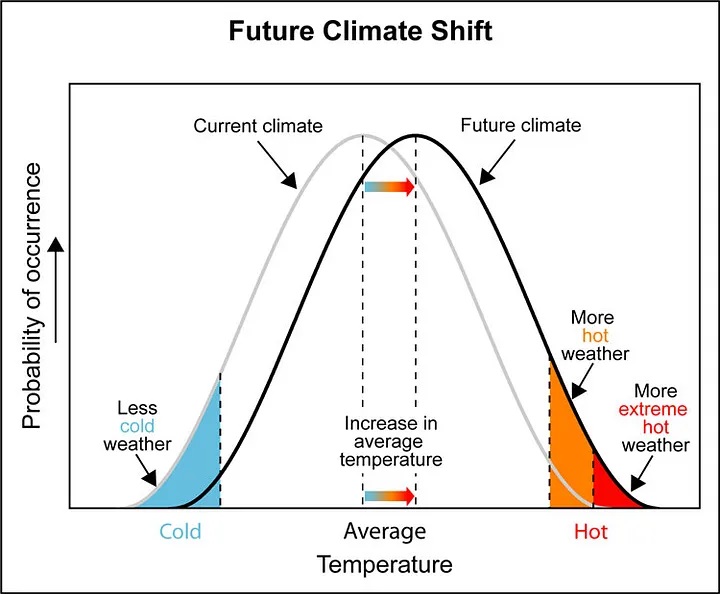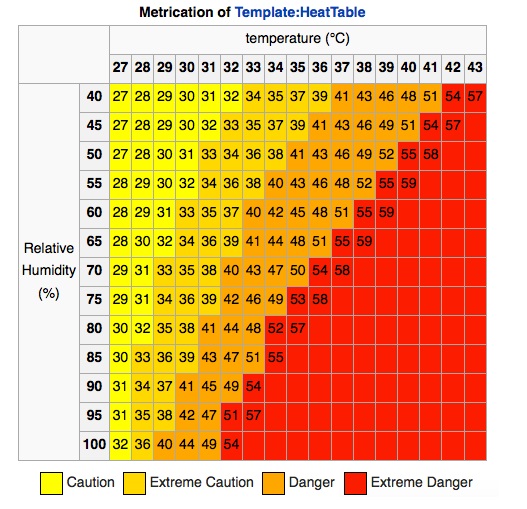What Happens When It Gets Too Hot To Live?

July 3rd was officially the hottest day ever, with the average global temperature reaching 17°C for the first time in recorded history. July 4th was even hotter. July 5th was just as hot. And July 6th was even hotter than that, prompting the UN to warn that climate change is out of control.
They’re absolutely right. High temperature records are being broken every single day. Last month, Beijing had its hottest June day in history. So did Mumbai. And Morocco. And Lancaster. And countless other cities and countries around the world. June was the hottest month ever by a huge margin, and this month will be the hottest July ever.
In America, the focus has been on the Texas heat wave, which has lasted for weeks and made Texas one of the hottest places on Earth, even staying hot at nighttime. Meanwhile, North Atlantic sea surface temperatures have been at a record high for months, and Antarctic sea ice extent has been hitting record lows for most of the year.
So what the hell is going on?
One of the reasons we’re seeing so much heat is the return of El Niño, which just began last month, and it’s likely to be a “super El Niño.” However, that doesn’t explain why the world is the hottest it’s been since record-keeping began. After all, El Niños occur every 3 to 5 years.
Another explanation is the UN’s decision to cut sulfur emissions from ships. While this reduced pollution, it also allowed more sunlight to hit the planet, heating it up even faster. Yet another explanation is the unusually low levels of Saharan dust, which normally shields the planet from some sunlight in the summer.
But these sorts of things have happened before. The main reason the planet is getting hotter is climate change. Unfortunately, only 5% of TV news segments mentioned climate change in their coverage of the Texas heat wave. No wonder Americans aren’t more alarmed.
For those of us who understand what’s going on, all of these high-temperature records are terrifying. The planet is currently about 1.2°C above the pre-industrial baseline, but we’re likely to reach 1.5°C in the next few years. And if James Hansen, the world-renowned climate scientist, is correct, we’ll probably reach 2°C by 2040.
Just 17 years from now.
Think about that for a moment. It has taken nearly 40 years for the planet to go from 0.4°C to 1.2°C above pre-industrial times. And now, the planet is going to warm that much again in less than half the time. This means the planet is warming exponentially.
It gets even worse. Many people have the impression that 2°C of warming will be twice as bad as 1°C of warming. So when we get to 2°C, we’ll have twice as many droughts, twice as many heat waves, twice as many wildfires, and so forth.
But it doesn’t work that way. As the planet warms, the impacts will also get exponentially worse. To understand this, imagine a bell curve of temperature distribution, with colder temperatures on the left and higher temperatures on the right.
Let’s say that at 1°C of warming, the highest possible temperatures only have a 1% chance of happening. As the planet warms, the entire bell curve shifts to the right, and a temperature that previously only had a 1% chance of happening now has a 10% chance of happening.

The result of this rightward shift will be heat waves that used to be virtually impossible. For example, the Pacific Northwest heat wave of 2021. It was the most extreme heat wave in world history, with temperatures topping previous records by as much as 9°F. The local marine life isn’t adapted to temperatures that high, which is why a billion sea creatures died.
All over the planet, species are going extinct because, among other reasons, temperatures are hitting new highs that the local flora and fauna have never experienced before. Since they didn’t evolve in environments with such high temperatures, they usually can’t survive them. It’s so bad that some biologists estimate 35% of plants and animals could go extinct by 2050.
Now lets turn our attention to humans. Obviously, there’s a limit to how much heat a person can withstand before dying of heatstroke, but where exactly is that limit? And when will places like Texas become too hot for humans? It all depends on humidity.
The human body cools itself by sweating. As sweat evaporates, it carries heat away, but if the air is too humid, then sweat can’t evaporate and the body is unable to cool itself. So if temperature and humidity are high enough, even someone sitting in the shade under a fan and drinking ice water would still die of heatstroke in a matter of hours, no matter how healthy they are.
To determine whether the air is too hot and humid for humans, scientists use something called wet bulb temperatures. Basically, a thermometer with a wet cloth wrapped around it will be cooler than a dry thermometer because of evaporation. But with 100% humidity, the wet thermometer will be at least as hot as the dry one because no evaporation can occur.
For example, if it’s 30°C outside but relative humidity is only 5%, then the wet bulb temperature will be about 10°C. But if relative humidity is at 100%, then the wet bulb temperature will be 44°C. You can find other wet bulb temperatures using the chart below or this calculator.

Until recently, scientists believed humans could survive in wet bulb temperatures up to 35°C. But last year, researchers at Penn State University found that the maximum wet bulb temperature humans can endure is 31°C.
That means a temperature of 30°C can be perfectly safe or very deadly, depending on how humid it is. And now you truly understand the meaning of the phrase, “It’s not the heat, it’s the humidity.”
Currently, wet bulb temperatures high enough to kill humans are very rare, but as the planet gets warmer, they’ll become more common. And not just because the planet is getting hotter, but also because it’s getting more humid. For every 1°C rise in temperature, the air can hold 7% more water vapor, so places that are already humid are going to get even worse.
High wet bulb temperatures are the reason 13 people in Texas and over 100 people in Mexico died during this recent heat wave. Fortunately, most people were able to avoid the heat by staying in air conditioned cars and buildings. But what happens when the power goes out and there’s no air conditioning?
You already know the answer.
Last month, India got hit with a scorching heat wave, and several regions in northern India lost power. Shortly thereafter, the local hospitals were overwhelmed with people suffering from heat-related illnesses. In the end, nearly 170 people died.
In a population of 1.4 billion people, 170 isn’t that many, but this is just the beginning. India is going to get more and more heat waves that break the human survivability limit. When that happens, power outages won’t be nuisances; they’ll be mass casualty events, like something out of a dystopian novel. Literally.
There’s a sci-fi novel by Kim Stanley Robinson called The Ministry of the Future, and in it, a heat wave causes so much demand for air conditioning that the power grid goes down and millions of people die. That exact scenario is going to happen in real life, and sooner than you think.
But of course, it’s not just India that’s in danger. The Middle East is warming twice as fast as the rest of the planet. By 2050, it will be uninhabitable. (Side note: What happens when half a billion people from the Middle East start migrating North? Chaos and fascism.)
Back in the United States, an extreme heat belt will form over the next few decades. The belt will stretch from Texas and Louisiana all the way up to Chicago, and residents living in the belt will see heat index temperatures as high as 125°F (52°C). Residents in the Southwest and parts of the East coast will also be in danger.
Many other parts of the world are also on the brink of sustained heat beyond human tolerance. In fact, scientists believe as many as 2 billion people will struggle to survive as the planet gets hotter. When that happens, the only way for them to survive will be with air conditioners.
But there’s a problem. Air conditioners require energy, and energy is getting more expensive. The world hit peak conventional oil back in 2005, and it looks like we’re hitting peak shale oil right now. Peak natural gas is also closer than you think, so the cost of fossil fuels has nowhere to go but up.
This is great for the climate, but unfortunately, we still have enough fossil fuels to raise the global temperature a lot more. There are alternatives such as wind and solar power, but we’re not investing nearly enough. Biden’s so-called Inflation Reduction Act includes some money for green energy, but it’s the bare minimum.
However, without an adequate power grid, it won’t matter how much energy is available — the grid still won’t be able to keep up with demand. Already, the Energy Information Administration fears that this year’s heat waves could cause energy shortages across 2/3 of North America. Meanwhile, the grid is slowly crumbling because power companies are pocketing their profits instead of reinvesting them.
But even if we rapidly modernized our power grid and added wind and solar as quickly as possible, it might not be enough. The Pacific Northwest Heat Wave of 2021 was so hot, it literally melted power cables. It doesn’t matter how modern or green your power grid is if the cables are melting.
The fact is, heat waves that kill people by the millions are inevitable. Maybe not this decade, but it’s going to happen within the lifetimes of most people alive today.
It’ll be interesting to see how the world reacts. Will we finally start taking extreme measures to mitigate climate change, or will we just fight each other for energy and water? Based on how we’re reacting to the current heat waves, it doesn’t look good.





Member discussion